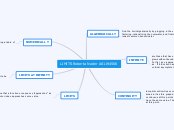LIMITS Roberta Nader A01194566
ALGEBRAICALLY
Find the limit algebraically by plugging in the x value, factoring, rationalizing the numerator, and finding the lowest common denominator.
INFINITE
are those that have a value of ±∞, where the function grows without bound as it approaches some value a. For f(x), as x approaches a, the infinite limit is shown as . If a function has an infinite limit at , it has a vertical asymptote there.
CONTINUITY
Jump discontinuities occur where the graph has a break in it as this graph does. The function is continuous at this point since the function and limit have the same value. The function is not continuous at this point.
NUMERICALLY
Find limits numerically by analyzing a table of values.
LIMITS AT INFINITY
Vertical asymptote is any value that makes the denomintaor Limf(x) x= negative or positive infinite be zero.
LIMITS
the value that a function or sequence "approaches" as the input or index approaches some value
